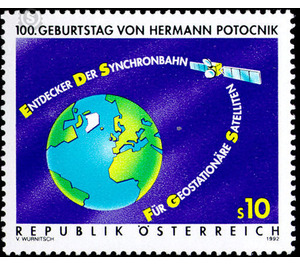100th birthday - Austria / II. Republic of Austria 1992 - 10 Shilling
Theme: Astronomy & Space
| Country | Austria / II. Republic of Austria |
| Issue Date | 1992 |
| Face Value | 10.00 |
| Color | green blue |
| Printing Type | Photogravure |
| Stamp Type | Commemorative |
| Item Type | Stamp |
| Chronological Issue Number | 1425 |
| Chronological Chapter | OOS-OE2 |
| SID | 160290 |
| In 72 Wishlists | |
The presentation on the special stamp already reveals it. The discoveries of space pioneer Hermann Potocnik are closely related to modern communication technology. The on December 22, 1892 son of K.u.K. Marinearts in Pola, Istria, née Hermann Potocnik is regarded as the discoverer of the geostationary synchronous track, one of the essential foundations of modern satellite and communication technology. The synchronous track at a height of approx. 36,000 km guarantees optimum transferability of radio waves. The scientist was denied international recognition for this groundbreaking discovery for a long time. It was only at a congress on 24 and 25 April 1976 that the contemporary significance of Hermann Potocnik for space exploration and space travel was expressly confirmed to aerospace scientists, cosmologists and guests from politics, business and intellectual life. As early as 1929, Potocnik wanted to build a manned space station on his synchronous track. But at that time one did not know yet that this orbit lies outside of the geomagnetic field, and is blown around by the solar wind, so it is unsuitable for manned flights. The under the pseudonym "Noordung" publishing Potocnik died, only 37 years old, on 27 August 1929.


